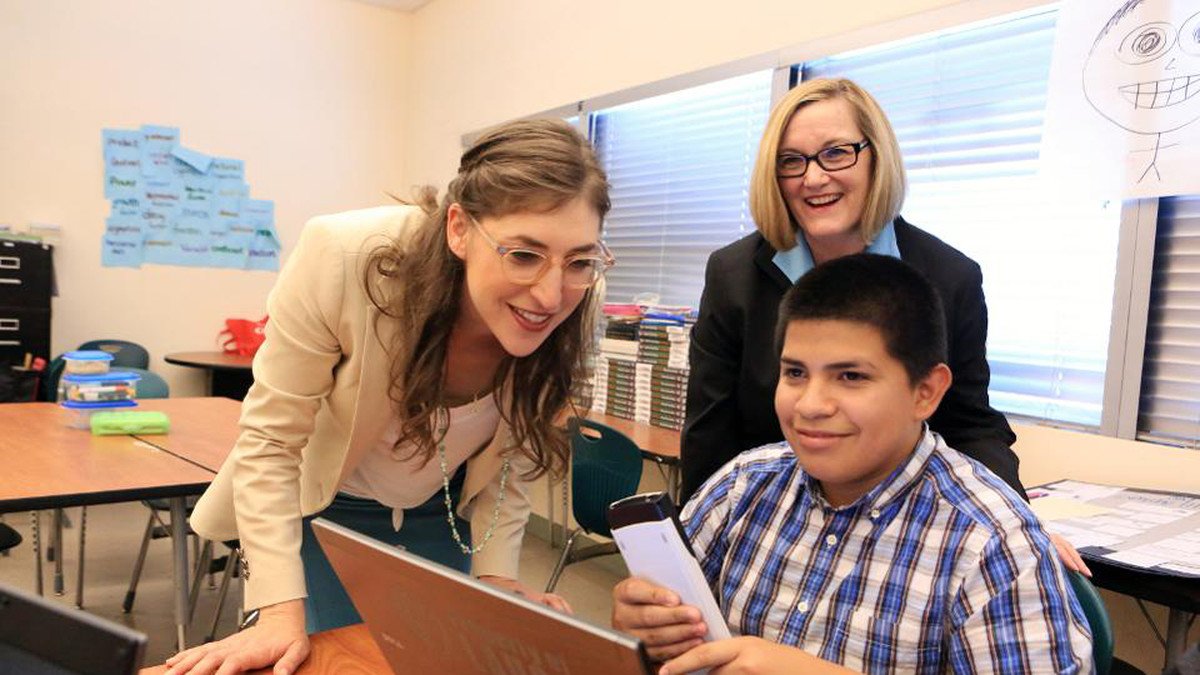[In the photograph above, actress Mayim Bialik, spokesperson and ambassador for TI, and Lisa Brady Gill, executive director of North America marketing, look on as STEM Academy student Alfredo Aranda works during a visit to classrooms prior to a presentation in which Bialik and TI presented the school with a $50,000 donation in education technology and professional development. Associated Press photo.]
We all learn at different rates in a school environment. But if we aren’t careful, late starters who might otherwise be very bright may fall behind their peers. If used properly, modern technology will “level the playing field” and allow each and every one of us to learn to our full potential in a way that suits our unique learning ability. Here are the various ways that modern technology can streamline the educational methodology and maybe help those of us with a slower grasp of certain concepts.
Virtual simulations
Many concepts in science, engineering, and math are difficult to understand without visual aids. Virtual models and simulations help teachers explain difficult ideas. This especially works well if the students are those who learn best by tactile or visual methods.
Online degrees
For those who are physically challenged and housebound or who work during the day, attending college and university is a problem. Many educational establishments, from Ivy League to community colleges, offer online courses. These range from vocational and work-based courses and certifications to full-blown degrees.
Better communication
Overworked teachers often find communication with their students problematic. There is pressure to complete coursework before exams, and classroom sizes often make one-to-one contact difficult. Technology can change classrooms into an information network. Teachers post assignments logically and progressively. While students ask questions in a forum made up of their teachers and classmates. Online communication is better for those students who have problems with speaking up in class, and allows for better peer-to-peer discussion. Students also have a structured communication record that can be referenced at any time.
Continuous assessment
Educational technology allows teachers to set practice exercises easier, as well as see their students’ progress. Software continuously monitors the answers to questions and how long it takes to answer. Grading and assessments are less prone to personal bias and teachers can see where individual students have problems. Teachers can, therefore, intervene privately in a more effective manner. Administrative staff can analyze data, identifying trends in teaching methods, students who are responding well and which ones need an alternative approach.
eBooks and advanced information
It is easier to access information using smart search engines and cloud storage than poring through reference books in a library. Just using a reference or quotation and all manner of information is immediately available. Therefore, because students save considerable time accessing information, they can research and consolidate many more concepts.
eBook-formatted textbooks are usually cheaper than traditional paper ones, so they will be more affordable for students. They will have them loaded on their tablet or laptop, or accessible via the school WiFi network.
Self-guided learning
One of the biggest advantages of technology is the ability for students to learn at their own pace. Some students will adjust to new concepts while others need more time to assimilate the information. Using technology, brighter students can move on to the next stage while others can use alternative learning methods. Slower students won’t feel intimidated by their lack of comprehension and can carry on with practicing the concepts after school, at home.
Learning should be fun
Learning and assimilating new information is always easier if it is a pleasant experience. Making the learning process fun results in better retention of information and more enthusiasm to learn. The student has many learning methods available; online videos, tutorials, and live streaming, as well as gamification and virtual reality. Each student will naturally find the best way to suit his or her own learning preference.
Access to information
There are many different free resources available online. Even if you don’t join an organized course, there is nothing to stop the interested person from learning on his or her own. Technology is an amazing educational resource that will help both teachers and students to realize their true potential.
This article was written by Ilker Koksal from Forbes and was legally licensed through the NewsCred publisher network. Please direct all licensing questions to legal@newscred.com.
![]()



